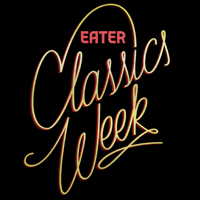/cdn.vox-cdn.com/uploads/chorus_image/image/64046105/clams-casino-window.0.0.1506931745.0.jpg)

For many New Englanders, it doesn't get more classic than clams casino. Whether at a classic red-sauce joint or at a oceanside seafood shack, the dish remains assuringly consistent: littleneck clams are propped on their half-shells with a mixture of peppers, bacon, bread crumbs, and butter, then broiled until each stuffed shell browns on top. In many diners' food memories, they arrive to the table on a bed of rock salt, with lemon wedges and parsley for optional garnishing.
But the birth of clams casino has a fuzzier history. The dish is most often credited to Julius Keller, who claimed to have invented the dish when he was an employee at Rhode Island's Narragansett Pier Casino. Contrary to its name, the Narragansett Pier Casino was not a gambling hall, but instead an upscale resort property built in the mid-1880s. (The resort suffered two catastrophic fires — one in 1900, the other in 1965 — but the property's signature towers structures remain, and today, the Towers operate mainly as a rental space for private events and weddings.) According to the Towers' director Kate Vivian, New York City restaurateur Louis Sherry, best known for his eponymous line of confections and chocolates, was one of the 10 people who built the resort. The "Sherry cottages," Vivian says, were situated about 1.25 miles away from the main resort, and offered guests access to several rental cottages with a restaurant situated in between.
Julius Keller was a Sherry employee, and in his 1939 memoir Inns and Outs, he lays claim to the dish: In Keller's account, one of the resort's guests, Mrs. Paran Stevens, requested a "special" clam dish for an eight-person luncheon she was hosting. Those eight guests were the first to taste what Keller called "clams casino," and according to Keller's memoir, his diner was rather pleased. "My introduction of them to the socially ultra Mrs. Stevens put me in her good graces for the remainder of the time I spent at Narragansett," Keller wrote.
:no_upscale()/cdn.vox-cdn.com/uploads/chorus_asset/file/3351430/mikes-kitchen2.0.jpg)
Clams casino at Cranston, RI's Mike's Kitchen.
But Keller's account doesn't specify the ingredients that went into that first clams casino. "The dish is really a gussied-up substitute for regular Italian stuffed clams, which have a simple filling of bread crumbs, garlic, and sometimes oregano," says Eater senior critic Robert Sietsema, a documented fan of clams. "[But] clams casino are mainly about the bacon." Like with another New England classic — clam chowder — it's likely the first clams casino recipe was influenced by the inspired pairing of clams and pork. (According to Jasper White, author of the cookbook 50 Chowders, the first known seafood chowder recipe was printed in the Boston Evening Post back in 1751, calling for "pork in slices very thin.") The dish's close relation to Italian stuffed clams would explain how it ended up a classic among the among the many Italian restaurants of Boston, Providence, and New Haven, Connecticut.
"Clams casino are mainly about the bacon."
Although the dish "was certainly served at other times" at the Narragansett Pier Casino apart from that fateful luncheon, Vivian says there's little documentation that definitively traces the dish's eventual appearance on menus. (The Narragansett's two fires, unfortunately, destroyed most of its records.) Popular myth argues the dish debuted in 1917, but evidence suggests its debut happened at least two decades beforehand. In 2005 article published in the Providence Journal, writer Arline A. Fleming dug up records of the clam-loving socialite Paran Stevens, discovering the Newport resident died in 1895. During the late 1890s, Vivian says, "it was common" for the social elite living in Newport to sail across the bay for lunch at the Narragansett Pier: So, it's completely plausible — and even likely — that Mrs. Stevens sailed across the bay for a luncheon of clams casino before her death. And according to etymology expert Barry Popik, some references to clams casino appear on New York City menus as early as 1900.
Today, the dish remains popular mostly in New England and along the eastern seaboard, as restaurants serve both classic and modern "updates" to the dish. As Sietsema points out: "The dish is just as likely to be found in old-guard Spanish restaurants as in Italian ones." Here's where to dig into some versions, old and new: